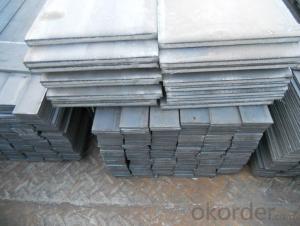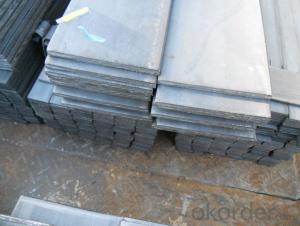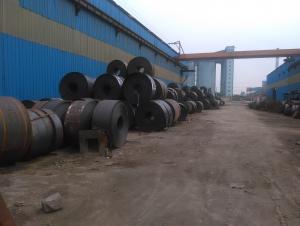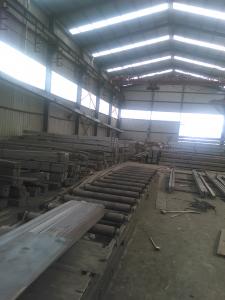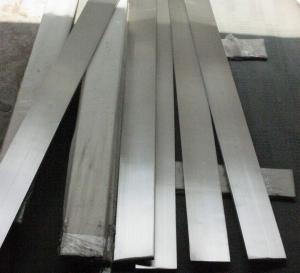Hot Rolled Seel Flat Bars with Material Grade Q235
- Loading Port:
- Tianjin
- Payment Terms:
- TT OR LC
- Min Order Qty:
- 25 m.t.
- Supply Capability:
- 10000 m.t./month
OKorder Service Pledge
OKorder Financial Service
You Might Also Like
Product Description:
OKorder is offering high quality Flat Bar at great prices with worldwide shipping. Our supplier is a world-class manufacturer of steel, with our products utilized the world over. OKorder annually supplies products to European, North American and Asian markets. We provide quotations within 24 hours of receiving an inquiry and guarantee competitive prices.
Product Applications:
Flat Bars are ideal for structural applications and are widely used in the construction of buildings and bridges, and the manufacturing, petrochemical, and transportation industries.
Product Advantages:
OKorder's Flats Barare durable, strong, and resist corrosion.
Main Product Features:
· Premium quality
· Prompt delivery & seaworthy packing (30 days after receiving deposit)
· Corrosion resistance
· Can be recycled and reused
· Mill test certification
· Professional Service
· Competitive pricing
Product Specifications:
Manufacture: Hot Rolled
Grade: Q195 – 235
Certificates: ISO, SGS, BV, CIQ
Length: 6m – 12m, as per customer request
Packaging: Export packing, nude packing, bundled
Chemical composition of Q235
Alloy No | Grade | Element(%) | ||||
C
| Mn
| S
| P
| Si
| ||
Q235
|
B
|
0.12—0.20 |
0.3—0.7 |
≤0.045 |
≤0.045
|
≤0.3
|
Physical properties of Q235
Alloy No | Grade | Yielding strength point(Mpa) | Tensile strength (Mpa) | Elongation after fracture(%) | ||||||
Thickness (mm) | Thickness (mm) | |||||||||
≤16 | >16--40 | >40--60 | >60--100 | ≤16 | >16--40 | >40--60 | >60--100 | |||
≥ | ≥ | |||||||||
Q235 |
B |
235 |
225 |
215 |
205 |
375--500 |
26 |
25 |
24 |
23 |
FAQ:
Q1: How soon can we receive the product after purchase?
A1: Within three days of placing an order, we will begin production. The specific shipping date is dependent upon international and government factors, but is typically 7 to 10 workdays.
Q2: How do we guarantee the quality of our products?
A2: We have established an advanced quality management system which conducts strict quality tests at every step, from raw materials to the final product. At the same time, we provide extensive follow-up service assurances as required.
Q3: The products are invoicing on theoritical weight or on actual weight basis ?
A3: We can do it in both manners, according to buyers' requiremnet.
Images:
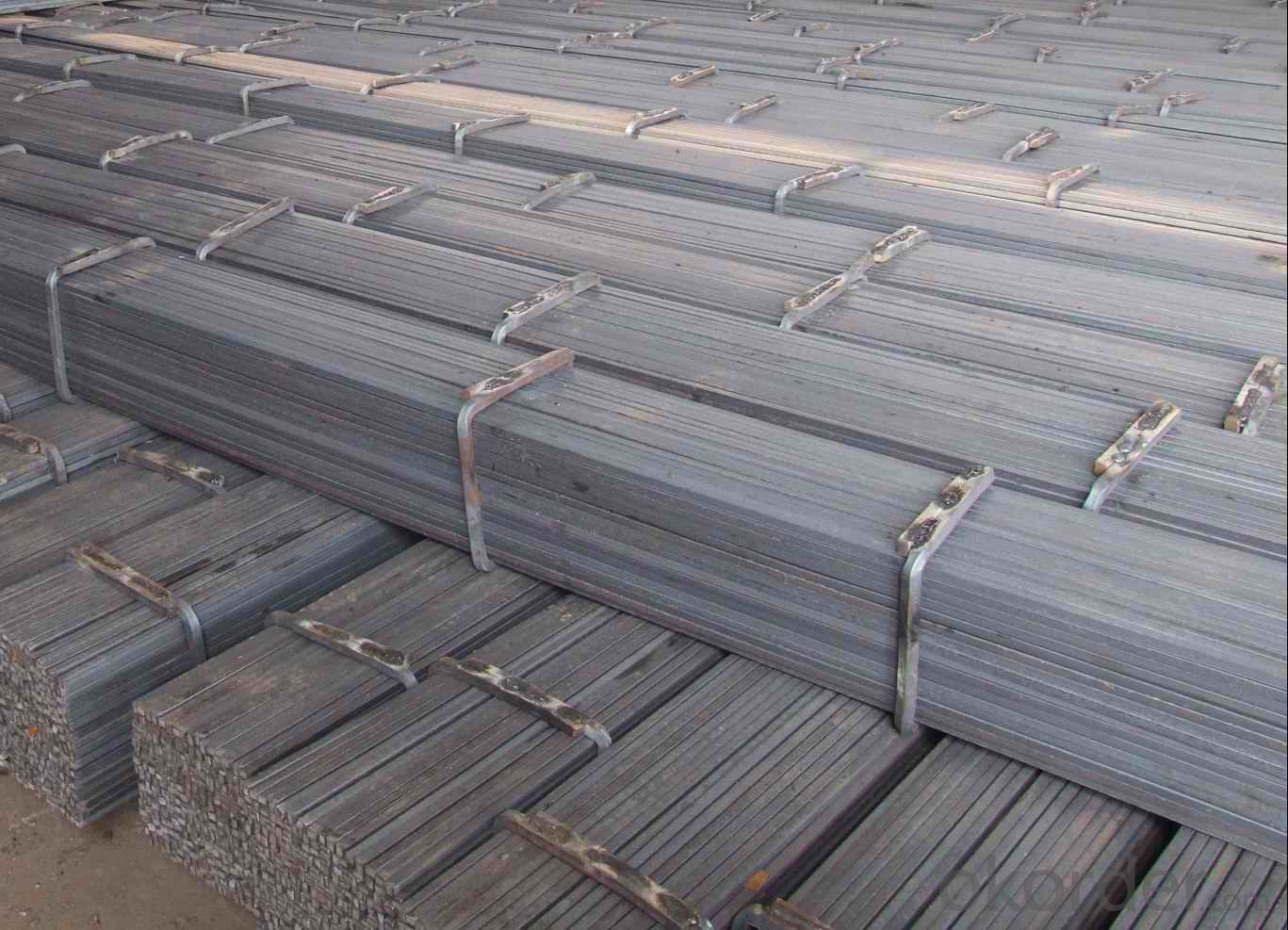
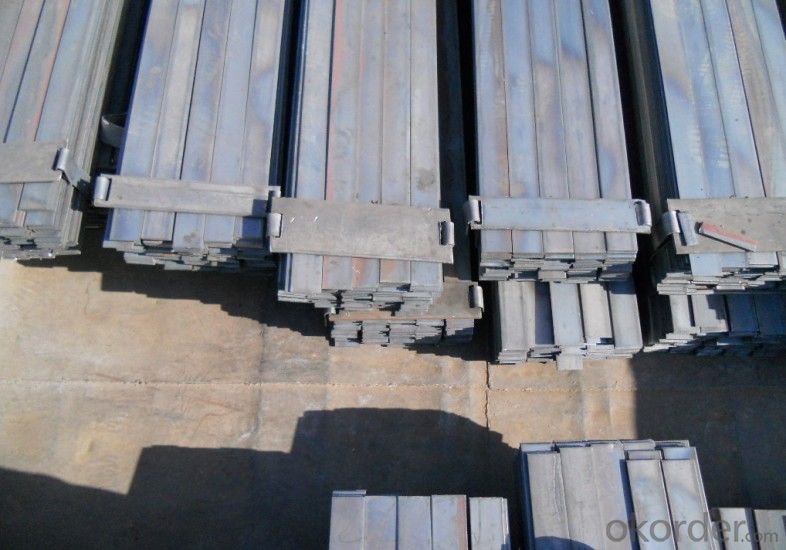
- Q:What are the common forming techniques used for steel flat bars?
- Some of the common forming techniques used for steel flat bars include hot rolling, cold rolling, and extrusion. Hot rolling is a process where the steel is heated above its recrystallization temperature and passed through a series of rollers to reduce its thickness and shape it into a flat bar. This technique is commonly used to produce steel flat bars with precise dimensions and a smooth surface finish. Cold rolling, on the other hand, involves passing the steel through rollers at room temperature. This process is typically used to further refine the thickness and surface finish of the steel flat bar produced through hot rolling. Cold rolling can also increase the strength and hardness of the steel. Extrusion is another forming technique that involves forcing the steel through a die to shape it into a flat bar. This process is commonly used for producing steel flat bars with complex cross-sectional profiles or when there is a need for a high degree of precision in the final product. Other forming techniques for steel flat bars may include bending, shearing, and welding. Bending is often used to achieve specific shapes or angles in the flat bar, while shearing is used to cut the flat bar to the desired length. Welding is a joining process that can be used to connect multiple steel flat bars together or to other steel components.
- Q:How can copper cables and flat steel be welded together?
- As a thin strip of copper or copper brazing Hanbian flat, the flat copper or steel crimping brazed or welded to the ground flat strip. Not copper brazing, tin soldered or crimped copper braid, then copper tape terminal is connected to the flat.
- Q:How do steel flat bars contribute to the overall flexibility of structures?
- Steel flat bars contribute to the overall flexibility of structures in several ways. Firstly, they can be easily bent or shaped into various forms, allowing for the creation of curved or non-linear structures. This flexibility in design helps architects and engineers achieve their desired aesthetic appeal and functional requirements. Moreover, steel flat bars possess high tensile strength, which means they can withstand significant external forces without breaking or deforming. This strength allows structures to be more resistant to bending, twisting, or collapsing under load, enhancing their overall flexibility and durability. Additionally, steel flat bars can be easily connected to other structural components using various methods such as welding or bolting. This versatility in joining allows for the creation of complex and adaptable structures, which can be modified or expanded in the future if needed. Furthermore, steel flat bars offer excellent fire resistance compared to other building materials. In the event of a fire, steel maintains its structural integrity and does not contribute to the spread of flames, ensuring the safety and flexibility of the structure. Overall, the use of steel flat bars in construction contributes significantly to the overall flexibility of structures by offering a wide range of design possibilities, high strength, easy connection methods, and fire resistance. These factors allow for the creation of versatile and adaptable structures that can withstand various external forces and meet the changing needs of the built environment.
- Q:What are the different cleaning methods for steel flat bars?
- Effective cleaning methods for steel flat bars can vary depending on the level of dirt or grime and desired results. Here are a few options: 1. Removing light dirt and dust can be easily achieved by using a mild detergent or soap mixed with warm water. Gently clean the surface using a soft cloth or sponge, then rinse thoroughly and dry with a clean cloth. 2. For tougher stains or rust spots, a mixture of vinegar or lemon juice with water can be applied. Allow the solution to sit for a few minutes, then scrub the affected areas with a soft brush or cloth. Rinse thoroughly and dry. 3. Baking soda can be turned into a paste by mixing it with water. Apply the paste to the surface and let it sit for a few minutes. Gently scrub with a soft brush, rinse thoroughly, and dry. 4. Commercial stainless steel cleaners specifically designed for steel surfaces are available in the market. These products effectively remove dirt, stains, and fingerprints from steel flat bars. Follow the instructions on the label for best results. 5. To achieve a shiny and polished appearance, polishing compounds can be used. Apply a small amount of the compound to a soft cloth and rub it in a circular motion on the surface of the bars. Buff with a clean cloth to remove any excess compound and enhance the desired shine. Always test a small and inconspicuous area first to ensure that the cleaning method does not damage or discolor the steel flat bars. Additionally, thorough rinsing and drying after cleaning are essential to prevent water spots and potential corrosion.
- Q:How do steel flat bars compare to titanium flat bars?
- Steel flat bars and titanium flat bars have some similarities, but also significant differences. In terms of strength, titanium flat bars are known to have a higher strength-to-weight ratio than steel flat bars. Titanium is a lightweight metal that exhibits exceptional strength, making it ideal for applications that require both durability and lightness. Steel, on the other hand, is heavier but still robust, offering good strength for various purposes. When it comes to corrosion resistance, titanium flat bars outperform steel flat bars. Titanium has excellent corrosion resistance, even in harsh environments, making it highly suitable for applications in marine, chemical, and aerospace industries. Steel, however, is more prone to corrosion and requires protective coatings or regular maintenance to prevent rusting. Another significant factor to consider is cost. Steel flat bars are generally more affordable compared to titanium flat bars. Titanium is a relatively rare and expensive material, which contributes to its higher price tag. Steel is widely available and has a lower cost, making it a more cost-effective choice for many applications. Additionally, titanium offers unique properties that make it stand out in certain industries. It has superb biocompatibility, making it valuable in medical and dental implants. Titanium is also non-magnetic, making it useful in applications that require non-magnetic properties, such as aerospace and electronics. In summary, titanium flat bars offer a higher strength-to-weight ratio, superior corrosion resistance, and unique properties like biocompatibility and non-magnetism. Steel flat bars, on the other hand, are more affordable and still provide good strength. The choice between the two will ultimately depend on the specific requirements of the application and the available budget.
- Q:How do you protect steel flat bars from UV radiation or sun damage?
- To protect steel flat bars from UV radiation or sun damage, one can apply a protective coating or paint that contains UV inhibitors. This will help to prevent the steel from fading, discoloration, or degradation caused by prolonged exposure to the sun's rays. Additionally, storing the steel flat bars in shaded areas, away from direct sunlight, can also minimize the potential for sun damage.
- Q:How do steel flat bars compare to other materials like wood or plastic?
- Steel flat bars have several advantages over materials like wood or plastic. Firstly, steel is an incredibly strong and durable material. It has a high tensile strength, meaning it can withstand heavy loads and resist bending or breaking. This makes steel flat bars ideal for applications where strength and stability are crucial, such as in construction or industrial settings. In comparison, wood and plastic are not as strong and can easily warp, crack, or break under pressure. Additionally, steel is highly resistant to weathering and corrosion. Unlike wood, which can rot or be damaged by insects, or plastic, which can fade or become brittle over time, steel flat bars can withstand harsh environmental conditions. This makes them suitable for outdoor applications, such as in fencing or furniture, where exposure to moisture or sunlight is a concern. Moreover, steel flat bars offer excellent fire resistance. Unlike wood, which is highly flammable, or plastic, which can melt and release toxic fumes when exposed to heat, steel is non-combustible and does not contribute to the spread of fire. This makes steel flat bars a safer choice in areas where fire safety is a priority, such as in commercial buildings or infrastructure. Furthermore, steel is a versatile material that can be easily shaped, welded, or manipulated to suit different design requirements. This flexibility allows for a wide range of applications, from structural support in buildings to decorative elements in furniture. In comparison, wood and plastic may have limitations in terms of their formability or the complexity of shapes they can achieve. Finally, steel flat bars have a long lifespan with minimal maintenance requirements. Unlike wood, which needs regular staining or sealing, or plastic, which may require periodic cleaning or polishing, steel flat bars are relatively low-maintenance. They do not need to be treated or protected against pests or weathering, reducing the overall costs and efforts associated with their upkeep. In summary, steel flat bars offer superior strength, durability, weather resistance, fire resistance, versatility, and low maintenance compared to materials like wood or plastic. These qualities make steel flat bars an excellent choice for various applications, especially in demanding environments where reliability and longevity are essential.
- Q:What are the fire-resistance properties of steel flat bars?
- Steel flat bars have excellent fire-resistance properties. Due to their high melting point, steel bars can withstand high temperatures without losing their structural integrity. In the event of a fire, steel bars do not burn or contribute to the spread of flames, making them a reliable choice for fire-resistant structures. Additionally, steel bars have low thermal conductivity, meaning they do not easily transfer heat, further enhancing their fire-resistance. Overall, steel flat bars are highly resistant to fire and are widely used in construction projects where fire safety is a priority.
- Q:Are steel flat bars suitable for machining processes?
- Yes, steel flat bars are suitable for machining processes. They have excellent machinability due to their uniform shape and smooth surface, allowing for easy cutting, drilling, and shaping. Steel flat bars also offer good strength and durability, making them a popular choice for various machining applications.
- Q:The function of ground lead out galvanized flat steel
- Use and test, debug, you must use lead line. In accordance with the D501 specification, its cross section is not less than 4*40.
1. Manufacturer Overview |
|
|---|---|
| Location | |
| Year Established | |
| Annual Output Value | |
| Main Markets | |
| Company Certifications | |
2. Manufacturer Certificates |
|
|---|---|
| a) Certification Name | |
| Range | |
| Reference | |
| Validity Period | |
3. Manufacturer Capability |
|
|---|---|
| a)Trade Capacity | |
| Nearest Port | |
| Export Percentage | |
| No.of Employees in Trade Department | |
| Language Spoken: | |
| b)Factory Information | |
| Factory Size: | |
| No. of Production Lines | |
| Contract Manufacturing | |
| Product Price Range | |
Send your message to us
Hot Rolled Seel Flat Bars with Material Grade Q235
- Loading Port:
- Tianjin
- Payment Terms:
- TT OR LC
- Min Order Qty:
- 25 m.t.
- Supply Capability:
- 10000 m.t./month
OKorder Service Pledge
OKorder Financial Service
Similar products
New products
Hot products
Related keywords


